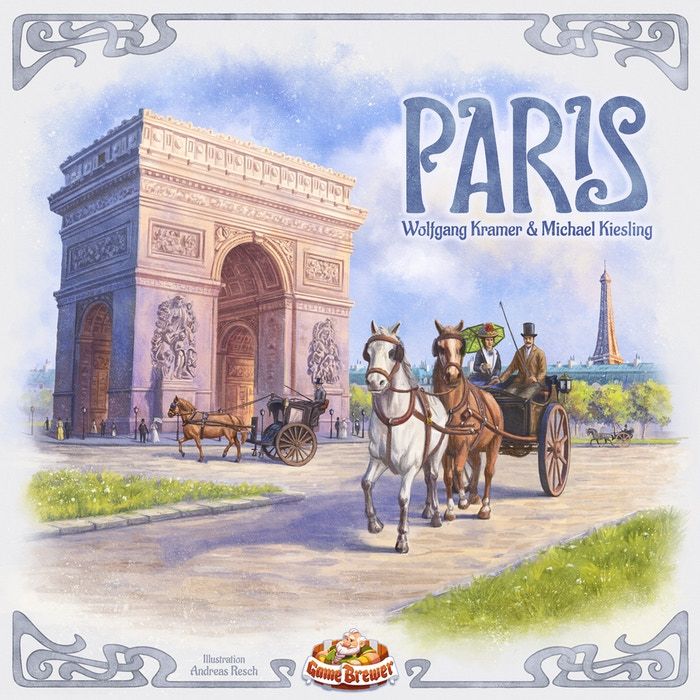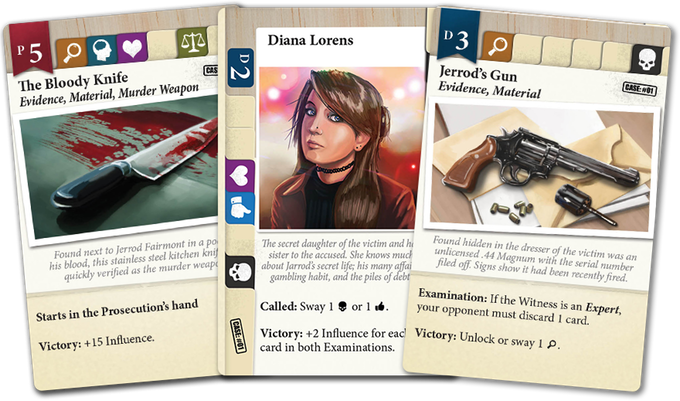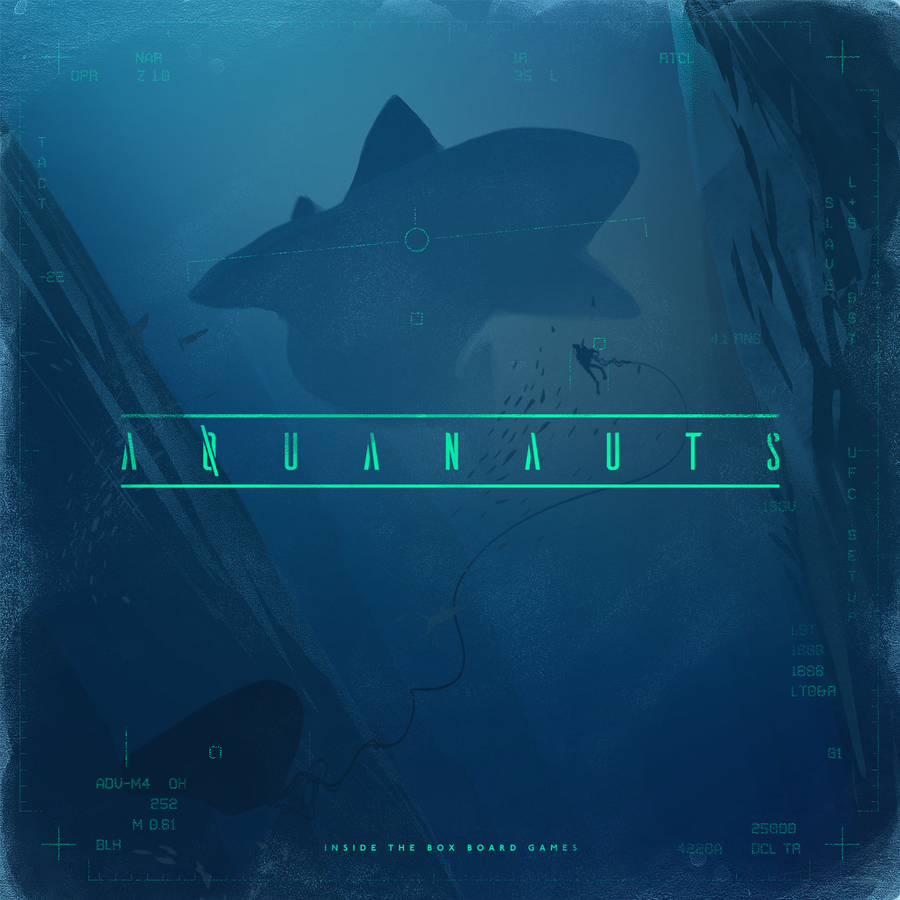Game Brewer
In their latest game Wolfgang Kramer and Michael Kiesling let us build the modern city of Paris. In Paris we’ll get to deal in real estate in Paris in la Belle Époque in the early 1900s. We’ll buy and trade buildings and landmarks in six districts around the Arc de Triomphe. Much of the game you’ll spend trading upwards into more valuable buildings. However, that’s not where your points come from. To score points you want to have expensive buildings in the most valuable districts, but you only set district value during the game. Another source of points and assorted goodies during the game are the thirty bonus tiles, but they lie on a track where your bonus tile collector meeple may only move in one direction, so you’ll have to decide how many tiles you want to skip in order to get the one you want. Paris is a prime example of what we love about Kramer/Kiesling games: the rules are fairly simple, the decisions you have to make are not.
Ravensburger
Finally, a game where all your character options are strong women. I can already hear certain people raging. Come on guys, the game is Wonder Woman: Challenge of the Amazons. Players have to work together to defeat three classic enemies of Diana Prince’s tribe: Ares, Circe, and The Cheetah. Not all at once, fortunately, you only pick one per game. Players fight back with three cards per round to trigger different actions to strike back against the villains. The problem is that when you’re allowed to plan together you don’t know all your cards yet. Wonder Woman: Challenge of the Amazons seems a fairly simple coop game, mechanically speaking, but the three villains each have their own rules that will keep you on your toes.
Board & Dice
Dark Ages is a fairly big strategy game. No matter which box you play, Heritage of Charlemagne or Holy Roman Empire, you’ll control a large part of Europe, command armies of miniatures, and develop your specific culture in the way you see fit. And then you put both boxes together and do all that with up to eight players spread across western and central Europe. Don’t be put off by the armies of miniatures, either. Dark Ages is much more a civilization builder than a wargame. Scale is not all it has going for it, either. It’s mechanically solid, but the innovative action selection mechanism especially stands out to me. When you pick an action you stack one of your action disks on top of that action space. If that space has three action disks now then the owner of the bottom one takes it out and takes one of the two reactions linked with that action. That’s a clever bit of interaction. When you pick your action you risk giving an opponent a reaction they really need, especially since taking resources is a reaction.
Kosmos
We missed Greenville 1989 when it was released by Sorry We Are French last year, but Kosmos’s announcement of a German version gave us a second chance. In the cooperative game by Florian Fay weird things happen to the players’ characters. Really weird things. For each character the players must work together to get them out of whatever trouble they are in. Only if this round’s guide and the rest of the players agree how a character’s story should continue does the story actually proceed. If all players make it to the rendezvous point they can safely escape Greenville. If a character fails to collect enough story cards they are lost to the Void and everyone loses the game. Greenville 1989 is somewhat similar to games like Mysterium, but creating a narrative from the beautiful, creepy cards is still a different experience than just guessing the right card. And while we’re talking about it, it appears there’ll be a sequel to Greenville 1989 called Paris 1889. Something else to look forward to.
Rock Manor Games
Courtroom drama is not a common boardgame setting. Surprising, really. The thrust and parry of argument and counterargument you see in courtroom shows seems like it should work in a game. That’s what Mike Gnade and Rock Manor Games must have thought, too, because their Kickstarter Lawyer Up lets you enter the courtroom battle. The two player asymmetric card game starts with drafting your deck. This step is going to be interesting already, because from each set of three cards you draw you add one to your opponents deck. They have no chance for objections, either. During the game proper you try to convince the jury of your witness or piece of evidence by playing a coherent argument, a chain of cards where each shares an icon with the previous one. Your opponent tries to do the same in order to discredit you. Which witnesses you call and what your overall strategy will be is also your decision. That sounds tense already, and to make things even better there are two expansions in the Kickstarter. One has a case from the prohibition era, the other goes all the way back to the witch trials.
Jellybean Games
Hidden role/social deduction games and supernatural creatures go together like werewolves and the full moon. This time, we’ll play at the Mummy’s coming out party – coming out of the sarcophagus, that is. The guests are an illustrious with big names like the Phantom of the Opera and an animated Statue of Anubis. To win Night of the Mummy you must find out who everyone is. Your one option is to outright ask someone if they have the role you’re asking for or not. Not subtle, but effective. The other option is to ask them to dance and show each other your character cards – or not, because some cards say that you dance with your mask on. Why would you go dance and give your own identity away? Because dancing lets you and your dance partner use your special abilities. It’s so simple, this should already be enough to play. Oh, and Night of the Mummy is compatible with its predecessor Dracula’s Feast: New Blood, so you can mix them up for a bigger party.
Amphora Games
Even the most mundane thing can make an exciting game. Pandemain: Traditional Farmers’ Bread is a worker placement game about baking bread in the medieval duchy of Swabia. Okay, you’re baking bread while the inquisition is after you, that always adds some excitement. Go to church to be seen as pious enough is not the only thing to do, though. Baking bread is a complex process, so you’ll send your workers to harvest different kinds of grain, which you then send them to grind at the mill, whence they go to the feudal lord’s oven to bake different styles of bread. That bread then still has to be sold in the surrounding villages, you have to make time for church so you won’t anger the aforementioned inquisition, you hire villagers to work for you, take loans if you have to, and you better do all of that quickly before the five rounds you have are over and before your bread goes stale on the shelves. YOu can see that Pandemain is much more complex than you might guess when I tell you it’s a game about baking bread. There is a lot to do, many resources to keep an eye on, and a lot of fine-tuning of prioritizing and timing to be done. Much, much more exciting than watching the dough rise!
Inside the Box Board Games
Worker placement works in any environment. Placing workers underwater is no problem. Okay, in Aquanauts you place robot workers, but that still counts! You use your worker bots for the acquisition of knowledge: collect samples, work in laboratories and expand the undersea research base. The expansion part is interesting because you build new spaces to put your bots on. How you connect those new facilities is important to make your game engine run efficiently. Interaction in Aquanauts is going to be particularly interesting. Robots working in adjacent facilities will earn extra resources, but Aquanauts is very much a competitive game… so place your workers better, down where it’s wetter, under the sea.
Floodgate Games
The Hindu’s Holi festival is about the prettiest holiday I know of. Participants throw brightly colored powder everywhere, and in the end everyone and everything looks bright and rainbow-colored. It’s fitting that in Floodgate Games’ Holi: Festival of Colors you don’t score victory points, you score joy. To score joy, you want to see as much of your own color on the three boards as possible. Yes, there are three boards, and what is really cool is that they “float” one above the other. To score the big points you want to go up and place your color tokens there. First, however, you have to get up there, which you can only do when you’re surrounded by color, and then you have to get your tokens to stay up, which they only do if the space below them is already colored. And you can’t just throw color wherever, you need a card that shows the right spot in relation to your pawn. Holi: Festival of Colors is beautiful, colorful, it is light and yet mechanically unique.
All or None Games
With a final expansion to their worker dice placement game Dicetopia All or None Games take you to the seedy part of town. Dicetopia: Crashing Waves adds a new board with three locations along the docks. Free thugs from Cutthroat Prison to help you control areas. Trade dice values at Molotov Market. Manipulate resource prices at the Crashing Waves Stock Exchange… I told you it was a seedy area. Crashing Waves gives a deservedly epic ending to the Dicetopia saga.
Garphill Games / Renegade Game Studios
Where do you go when there’s no North Sea left to raid? Scythia, apparently. Raiders of Scythia is a sequel of sorts to Raiders of the North Sea. It takes you from viking lands to central Eurasia and it gives you eagles and horses that can now supplement your crew. Variable player powers make an entry as well. Besides those changes Raiders of the North Sea veterans will instantly feel at home in Raiders of Scythia when Garphill Games release it later this year.
The Pen & Dragon
Salty spray stings your eyes, smoke burns your throat. Battle rages around you, but if you’ve seen any movies you know that only the captains’ duel decides who wins the day. That’s where the action is in Salt & Bones, a two player dueling game. Players take turns mostly playing attack cards on the board. They deal damage to your opponent, but every attack also creates opportunities that both sides can use. As the game progresses, placing those attack cards gets harder and harder because the battle is raging around you and bits of the deck collapse or catch fire. Both sides also have strategy cards at hand that can dramatically alter the course of the fight. If you pay attention at least your opponent’s strategies won’t completely blindside you. Pay attention what kind of card they draft and you might get an idea what cards they already got. Like a real sword fight Salt & Bones is not complicated, but it’s tense.
This week’s featured photo was once more taken by Xiquinho Silva, whom I envy a bit for the wide spread of world heritage sites he’s visited. This photo shows the entrance to a fortress on Okinawa, Japan, that was once part of the Kingdom of Ryukyu. Thanks for sharing this photo, Xiquinho! (81439-Okinawa, Xiquinho Silva, CC-BY, resized and cropped)





